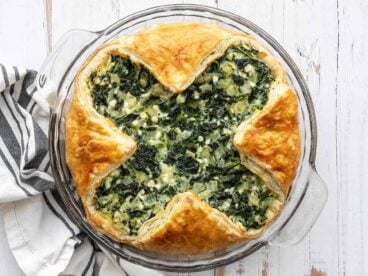
Now love yourself and enjoy this one ...
If you want your whole family clamoring around the dinner table with a dish everyone will love, this Veggie Pot Pie is All. Of. The. Things! Creamy, savory, hearty, crispy- you can even make this Veggie Pot Pie recipe vegan! It’s all cooked in a velvety sauce and encased in a flaky, buttery pie crust. Are you ready to make the ultimate comfort food? (Say yes!!!)
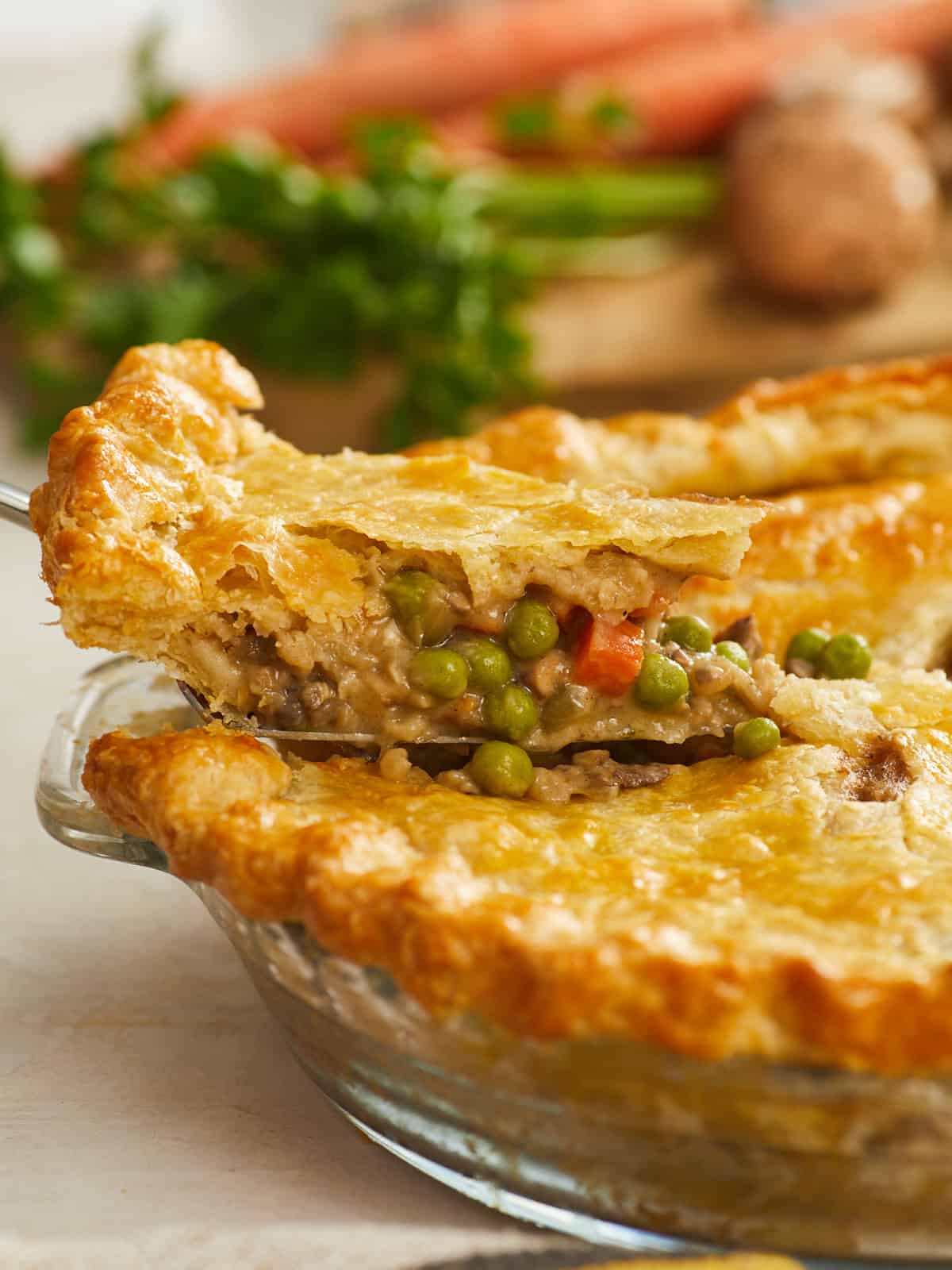
What Is Veggie Pot Pie?
A pot pie is just like a regular pie, except it’s usually savory and made in a creamy sauce. Pot pies can be made with a bottom and top crust or just a top crust. This pot pie recipe is a mix of colorful vegetables drenched in a savory gravy and cooked in a deliciously flakey double crust. Feel free to use just a top crust if you prefer it that way. I’m a crust person, so the more, the better!
What You’ll Need
For The Filling
- Butter and Flour- with their powers combined, you’ll make a roux, and that blend of fat and flour will thicken your sauce.
- Milk and Vegetable Broth- this is the base of your creamy sauce. You can substitute the milk with plant-based milk if you want to keep this bad boy dairy free. Alternatively, if you want to add more depth, try using chicken broth.
- Mushrooms, Onions, Potatoes, and Mixed Veggies- these are the stars of your veggie filling. To minimize chopping, I use frozen mixed veggies. But any combination of veggies you have on hand will work. Just make sure to chop everything the same size and par-cook root veggies in the broth first.
- Rosemary, Thyme, Bay Leaf, and Sage- add flavor and depth to the sauce. You can substitute them with your favorite spice blend.
- Soy Sauce- adds umami, AKA savoriness, which anything vegetable-based will need loads of. You can also use a teaspoon of any Miso you have on hand or Worcestershire Sauce.
For The Crust
- Double Pie Crust- encases everything in a buttery dream and adds incredible texture. You can use a store-bought crust, but I use my 3-Ingredient Pie Crust. You can also use puff pastry, but par-bake it before filling.
- Egg- the white seals the bottom crust, so it doesn’t absorb liquid, and the yolk lacquers the top crust, giving you a golden finish. If you want to skip the egg, par-bake the bottom crust and use milk, cream, or plant-based milk to lacquer the top crust.
Make It Vegan
You can tweak this recipe to create an outstanding Vegan Pot Pie! Sub the butter with vegan butter or oil. Opt for a store-bought vegan pie crust, or make my Easy 3-Ingredient Pie Crust with Vegan Butter or Vegetable Shortening. Sub the milk with any plant-based milk. As far as the egg wash is concerned, you can brush your pie crust with water, aquafaba, or plant-based milk. Par-bake the bottom crust before filling.
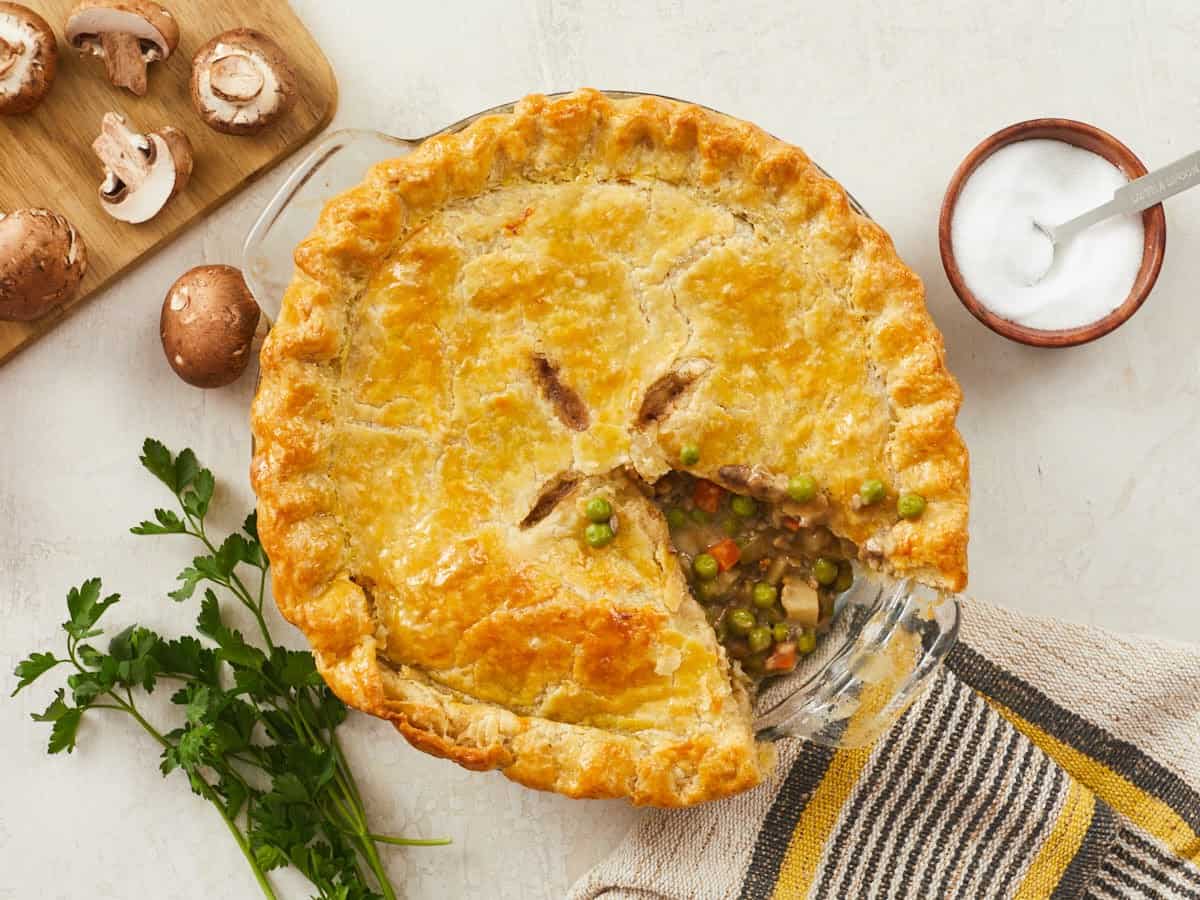
Prevent A Soggy Bottom Crust
Brushing the bottom crust with egg white helps create a barrier that prevents the dreaded soggy bottom. You should also preheat the oven with a sheet pan in it. When you place the pie on it, the heat from the sheet pan melts the fat in the bottom pastry, creating a layer that prevents liquid from permeating the pie. You can also place an overturned cast iron skillet in your sheet pan and preheat them both. Bake your pie on the bottom of the overturned skillet. Cast iron holds heat and helps crisp up that bottom crust.
How To Store The Leftovers
You can store leftovers in an airtight container in the fridge for up to 4 days, though reheating is easier if you just store them in the pie plate and cover them tightly with foil. You can freeze a veggie pot pie for up to 2 months, tightly wrapped in plastic, then foil, and kept in an airtight container. Cover the top crust with foil to prevent burning, and reheat in a 350ºF oven until it has warmed throughout.
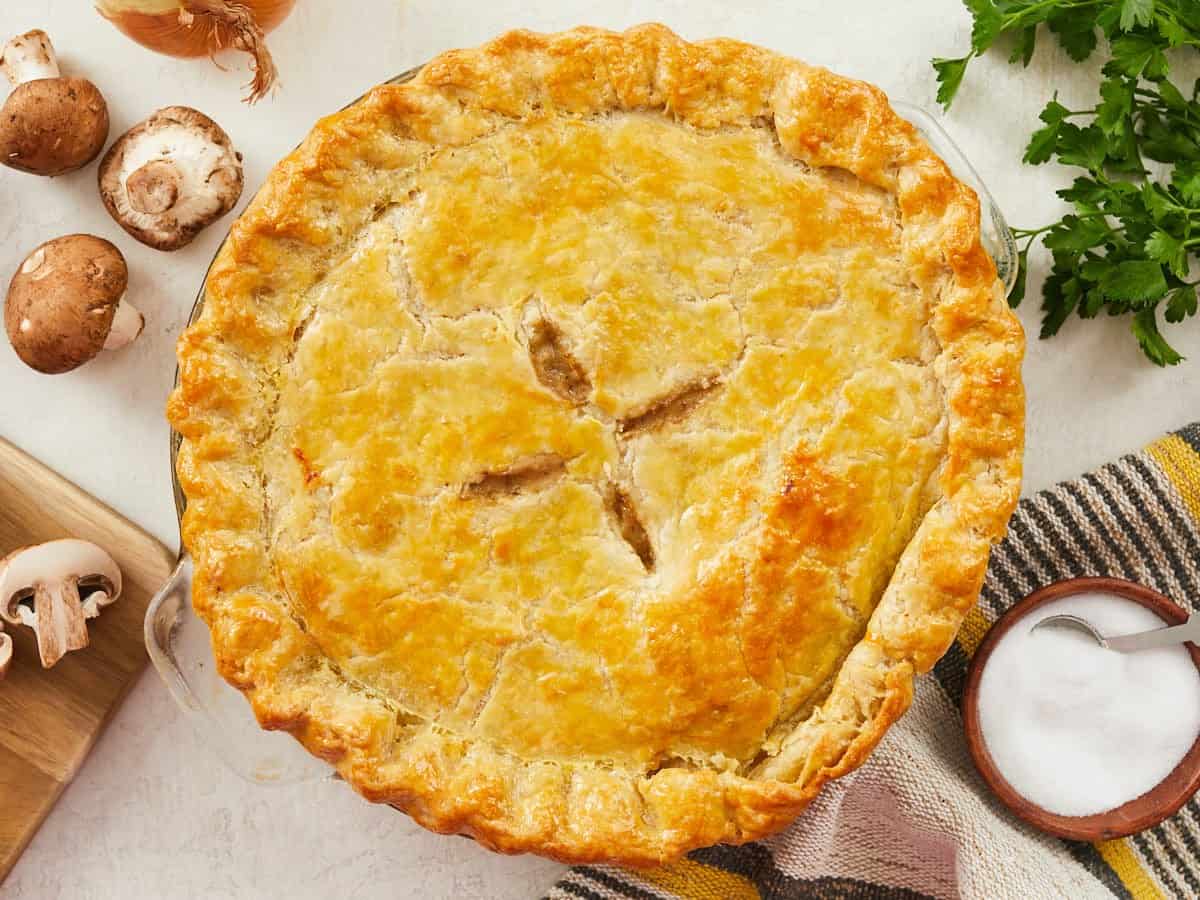

Veggie Pot Pie
Equipment
- Glass Pie Plate
- Rolling Pin
- Enamelware Sheet Pan
- Deep Stainless Steel Skillet
Ingredients
- 1 3-Ingredient Pie Crust* $2.34
- 7 Tbsp salted butter, divided $1.12
- 1 yellow onion, small dice (about 1 cup) $0.41
- 2 garlic cloves, minced (about 1 teaspoon) $0.24
- 4 Tbsp flour $0.04
- 1 cup veggie broth $0.13
- 1/2 cup whole milk $0.13
- 3/4 tsp salt $0.05
- 1 bay leaf $0.15
- 1/4 tsp ground rosemary $0.03
- 1/4 tsp dried thyme $0.03
- 1/4 tsp rubbed sage $0.03
- 1/4 tsp black pepper $0.02
- 1 tsp soy sauce $0.02
- 1 Yukon gold potato, small dice* (about 1 cup) $0.27
- 1 pint baby bellas, small dice $2.89
- 12 oz frozen mixed vegetables $1.25
- 1 egg, separated $0.46
Instructions
- Grease a pie pan with 1 tablespoon of butter. If you're using store-bought dough, place the bottom crust in the pie pan. If you made 3-Ingredient Pie Crust, cut 1/3 of the dough off to be used as the top crust, wrap it in plastic, and refrigerate until you're ready to use it later.
- Dust your work surface with flour and roll out the bigger 2/3 piece of dough into a circle that is 16 inches in diameter and about 1/4 inch thick. Line the pie pan with it.
- Beat the egg white until frothy, then brush the bottom crust with it. Let the crust rest in the fridge.
- Place a rack in the center of your oven along with a sheet pan and preheat it to 350ºF. Place a deep skillet over medium heat and add 5 tablespoons of salted butter to the pan. Once the butter foams, swish it around the pan until it turns an amber color and smells of hazelnuts.
- Add the diced onions to the brown butter. Cook until the onions are translucent, about 5 minutes. Add the garlic, and cook for one minute. Sprinkle the flour over the onions and garlic in the skillet and continue to cook and stir for two minutes more.
- To the pan, add veggie broth, milk, and salt. Whisk to combine and dissolve any flour off the bottom of the skillet. Then add the bay leaf, rosemary, thyme, sage, pepper, and soy sauce. Whisk occasionally as the liquid simmers and thickens.
- Add the pint of diced mushrooms and the diced potato to the pan. Stir to combine and cook until the gravy has thickened more and reduced some, about 5 minutes.
- Remove the skillet from the heat. Finally, add the frozen mixed vegetables and allow them to cool the ingredients in the pan.
- Take the pie pan out of the fridge, prick the bottom crust a few times with a fork, and add the cooled filling to the pie pan. Dice the last tablespoon of butter and sprinkle it over the filling.
- Roll the smaller piece of dough into a circle, about 10 inches wide and 1/4 inch thick. Cover the pie with it.
- Beat the egg yolk. Trace a bit of yolk along the top edge of the bottom and top crusts. Fold the bottom crust over the top crust and crimp the edges shut. Cut vents into your top crust. Brush egg yolk in a light layer over the top crust.
- Bake for 45 to 50 minutes, or until the pie dough is golden and flaky. Allow the Veggie Pot Pie to cool for ten minutes before serving.
See how we calculate recipe costs here.
Notes
Nutrition
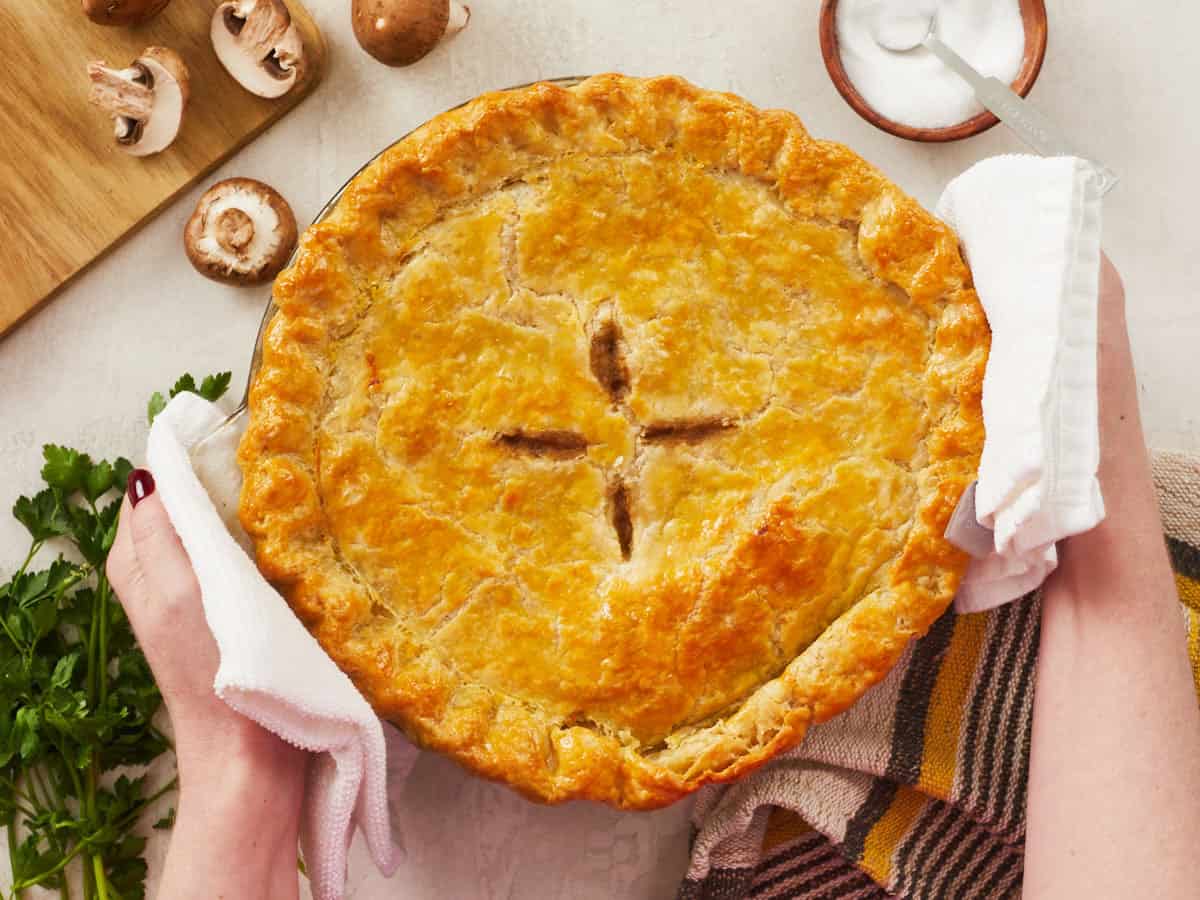
How to Make Veggie Pot Pie - Step by Step Photos

Grease a pie pan with 1 tablespoon of butter. If you’re using store-bought dough, place the bottom crust in the pie pan. If you are making 3-Ingredient Pie Crust, roll it into a large disc about 6 inches wide and two inches thick. Then cut 1/3 of it off to use as the top crust later on. Wrap it in plastic, and refrigerate.
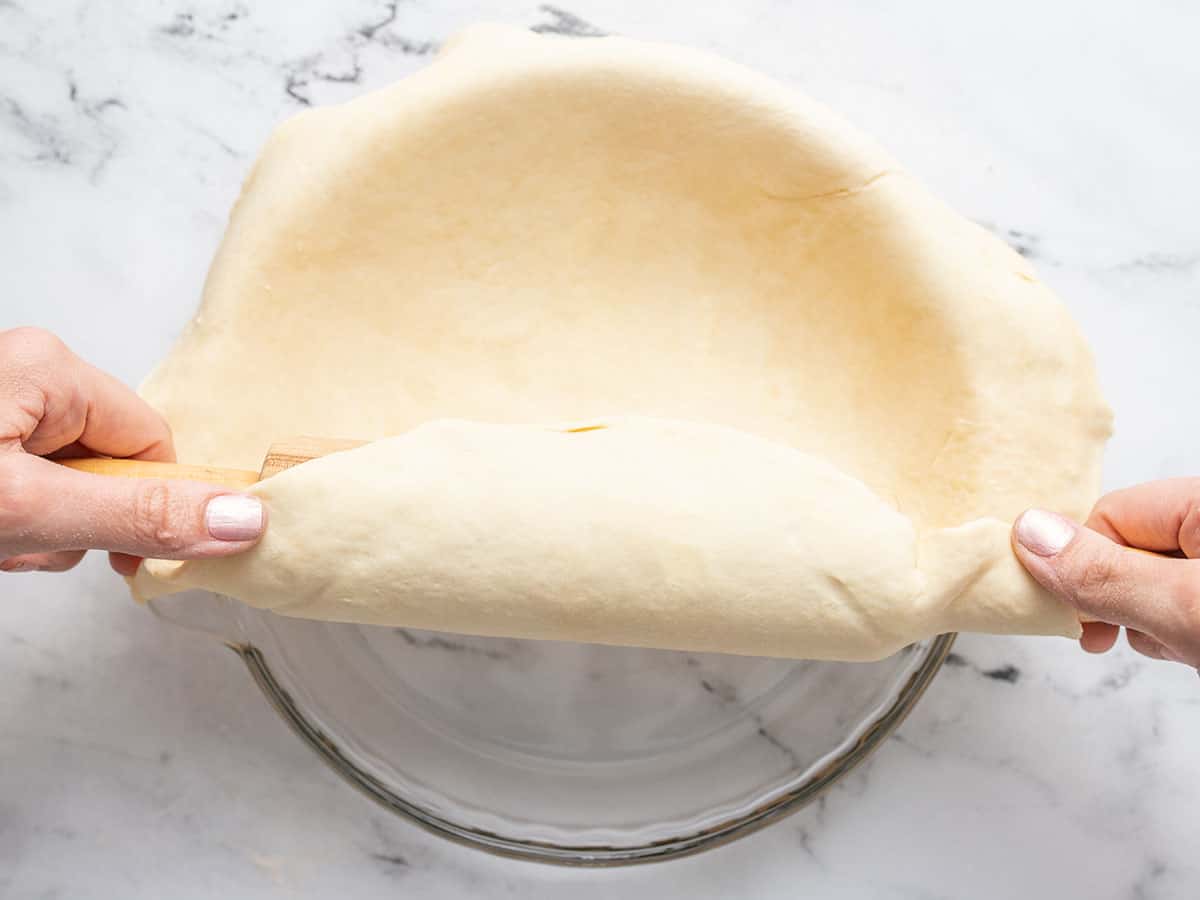
Dust your work surface with flour and roll out the bigger 2/3 piece into a circle that is 16 inches in diameter and about 1/4 inch thick. Drape it over the pie pan and press down gently, gently pushing it into the bottom crease and sides of the pan.
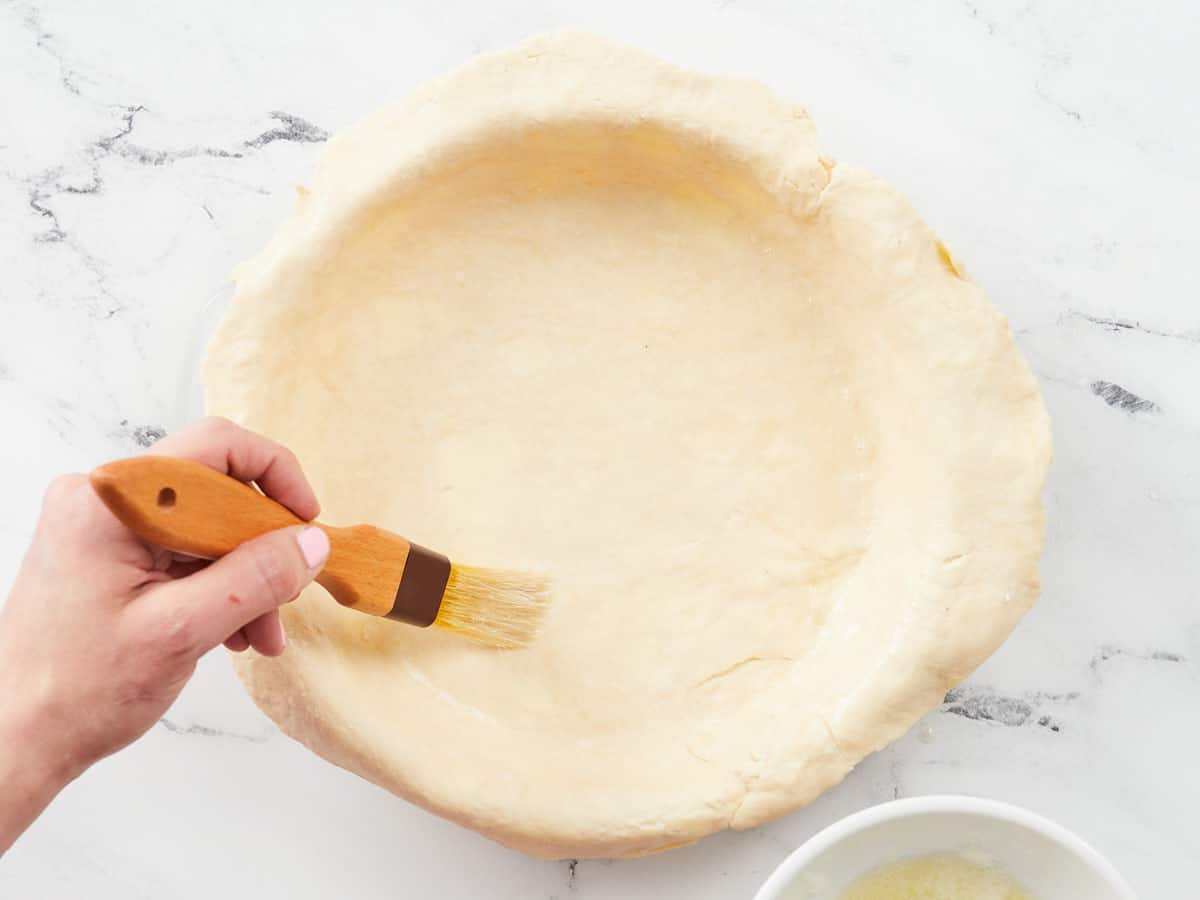

Place a rack in the center of your oven along with a sheet pan and preheat it to 350ºF. Place a deep skillet over medium heat, add 5 tablespoons of salted butter to the pan, and brown it. The butter will melt, then foam, and finally, the solids will separate from the fat and turn a golden brown. The air will smell of hazelnuts.

Add the diced onion to the brown butter. Cook until translucent, about 5 minutes. Then add the 2 minced cloves of garlic and cook for 1 minute, until fragrant. Finally, sprinkle 4 tablespoons of flour over the onions and garlic in the skillet and continue to cook and stir for 2 minutes more.

Add 1 cup of veggie stock, 1/2 cup of milk, and 3/4 teaspoon salt. Then whisk to combine and dissolve any flour off the bottom of the skillet. Finally, add the bay leaf, 1/4 teaspoon rosemary, 1/4 teaspoon thyme, 1/4 teaspoon sage, 1/4 teaspoon black pepper, and 1 teaspoon soy sauce. Whisk occasionally as the liquid comes up to a simmer and thickens into gravy.

Next, add the pint of diced mushrooms and the diced potato to the pan. Stir to combine and cook until the gravy has thickened more and reduced some, about 5 minutes. You want to cook the potatoes a touch, to ensure they cook fully in the oven.
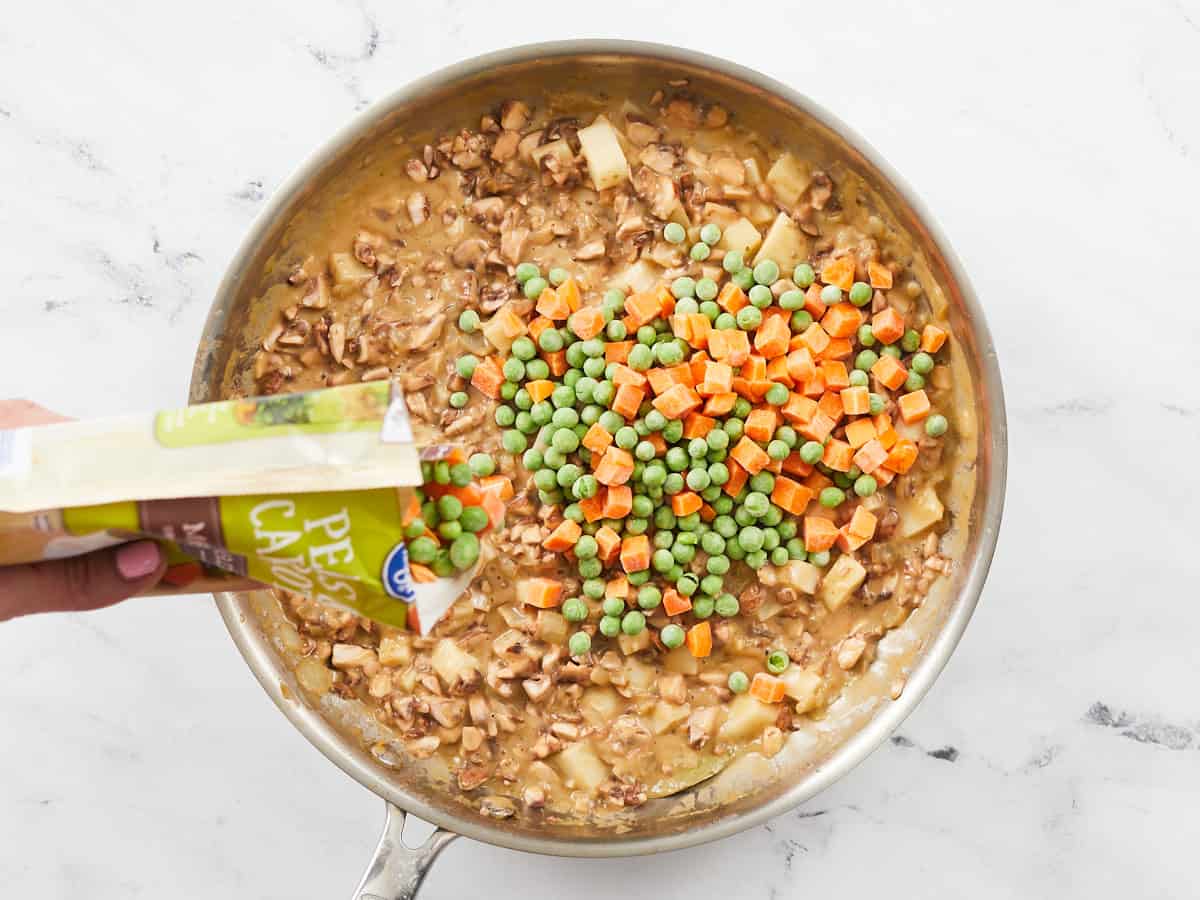
Next, remove the skillet from the heat. Finally, add the 12 ounces of frozen mixed vegetables to the filling, where they will quickly cool the other ingredients in the pan. Your filling is done!
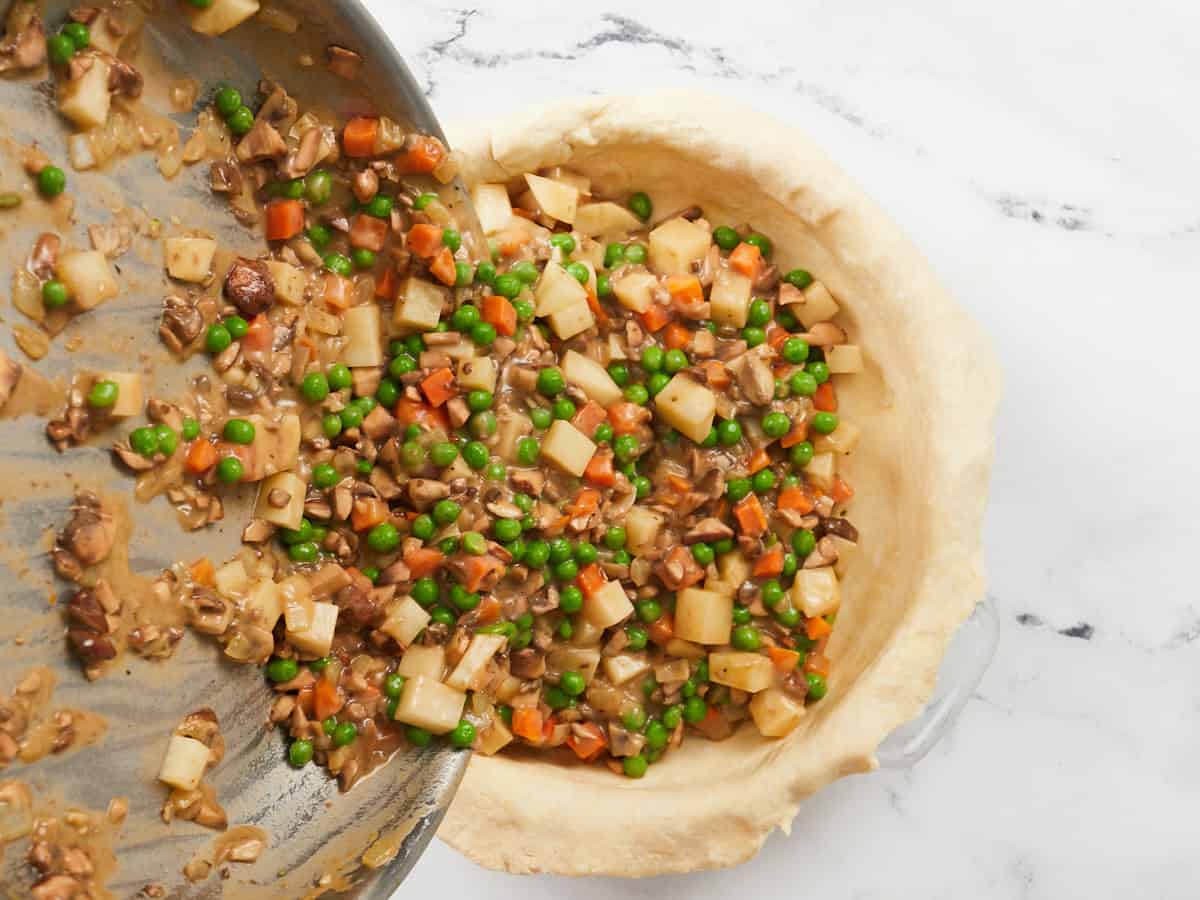
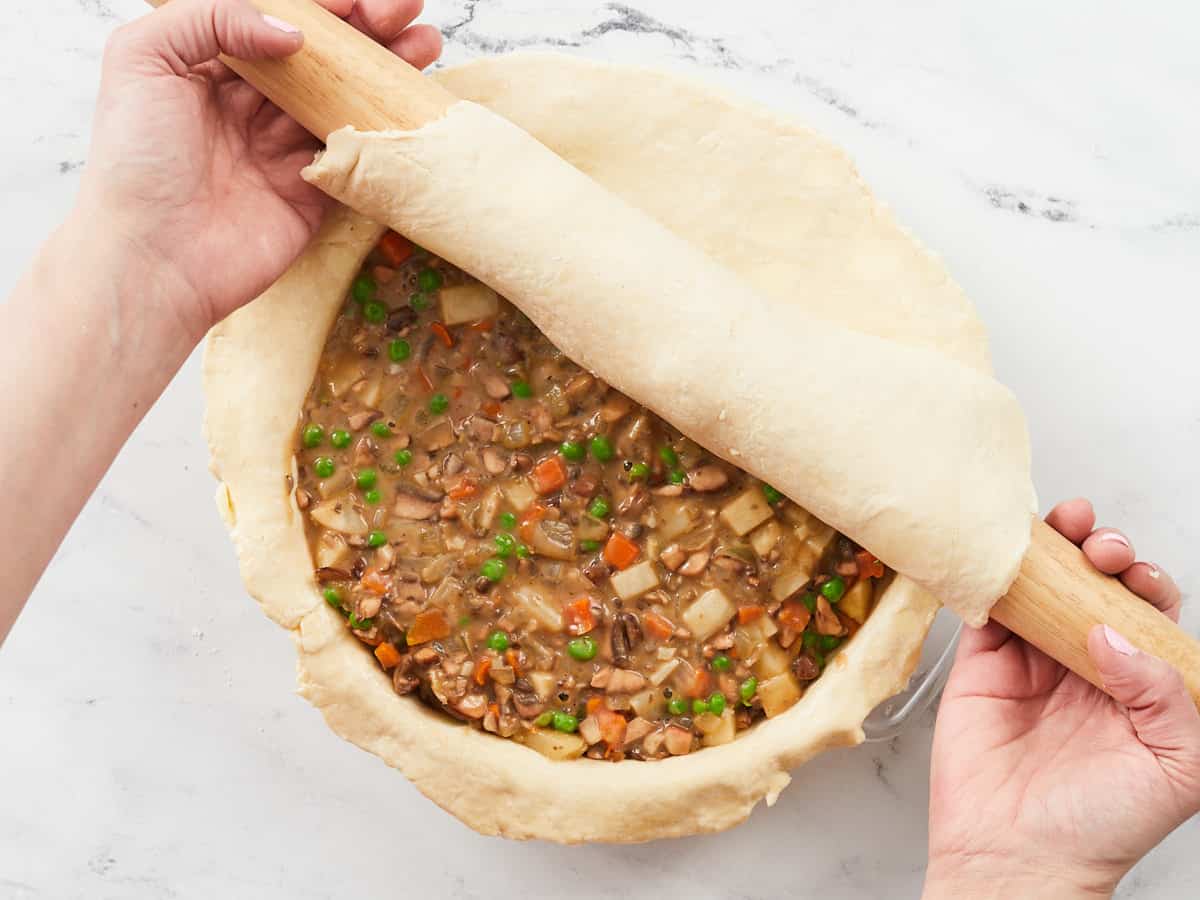
Roll the smaller piece of dough into a circle, about 10 inches wide and 1/4 inch thick. Cover the pie with it.
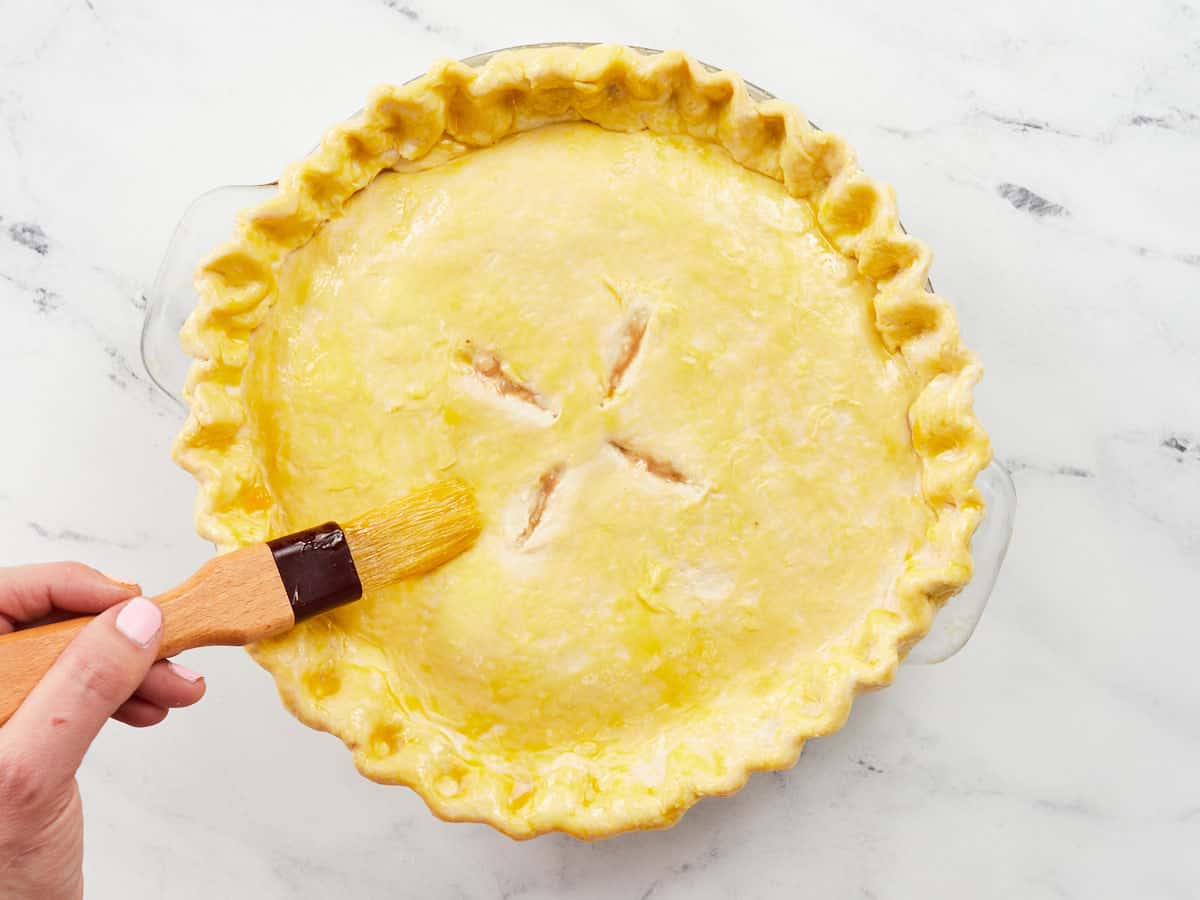
Beat the egg yolk. Then trace a bit of yolk along the top edge of the bottom and top crusts. Fold the bottom crust over the top crust and crimp the edges shut. Cut vents into your top crust. Finally, brush the egg yolk in a light layer over the entire top crust.

Bake for 45 to 50 minutes, or until the pie dough is golden and flaky. Allow the Veggie Pot Pie to cool for ten minutes before serving. I gobbled up three slices of this in one sitting! I hope you do the same!

Other Great Savory Pie Recipes


Chicken Pot Pie

Vegetarian Shepherd’s Pie
The post Veggie Pot Pie appeared first on Budget Bytes.
By: Monti - Budget BytesTitle: Veggie Pot Pie
Sourced From: www.budgetbytes.com/veggie-pot-pie/
Published Date: Mon, 13 Feb 2023 18:17:38 +0000
Frequently Asked Questions
What are the 11 Indian spice blends?
The eleven spices of Indian cuisine are coriander seeds, cumin seeds, fennel seeds, mustard seeds, nigella seeds, black pepper, cloves, cinnamon sticks, dry red chili powder, turmeric, and cardamom.
These ingredients are used in almost every dish. These spices are used in almost every dish, including curries, curries, chutneys (pickles), rice, bread and sweets.
The health benefits of spices can be found in their medicinal properties. For example, turmeric helps fight cancer cells. Cloves protect against bad breath. Black pepper lowers cholesterol. Cinnamon lowers blood pressure. And ginger aids digestion.
The spice rack is an excellent kitchen tool as it allows you to experiment and create new combinations of flavors. You can either make your own spice blends or purchase ready-made spices.
Some people prefer not to add any spices to their food. Some people believe spices can only mask the natural flavor of food and don't improve it. There is nothing wrong with adding salt or pepper to enhance the flavor of your meals.
Most chefs agree that spices are an essential part of cooking art. Many dishes would be bland and tasteless without spices. So next time you're feeling adventurous, why not try a new recipe and see what happens?
What Spices or Herbs Go Best With Potatoes?
A potato can be a side dish for any type of meat. You may be familiar with the many ways you can serve potatoes other than mashed.
These versatile vegetables are great additions to many meals, including casseroles, soups and pasta dishes. Many spices and herbs are good with potatoes, did you know?
Spice up your following potato recipe with these delicious recipes.
What are the main Flavours of Thai Cooking?
Thai cuisine includes several distinct regional cuisines. These include Northern and Central Thai cuisines, as well as Southern, Eastern, Western, Eastern, Western, Northeastern Thai food. Each region has its unique flavour profile.
The most common flavours in Thai food are sweet, salty, sour, spicy, bitter, pungent, and nutty.
Thais appreciate sweetness. It makes Thai food taste better. Thai cuisine has a lot of sweet ingredients such as coconut milk and palm sugar (gula Melaka).
Sourness is also very popular in Thailand. Hot dishes can often be paired with sour foods. This combination balances out the heat.
Thai food has a lot of spicy ingredients. Thai cuisine uses a lot of spices, including galangal ginger root, chilli pepper, and garlic.
What's the importance of spices in your life?
A spice is an ingredient that adds flavor to food. Spices come in various forms, such as powders, liquids, gums, oils, pastes, and seeds. They are also known for their versatility and ability to be used as flavours and condiments.
You can spice up meals to make them more interesting. Numerous spices can be added to dishes for extra flavour and excitement.
Hot pepper sauce may make soup taste better. You could also add a few cayenne peppers to a cup of rice.
Fresh ingredients are the best option to spice up your recipes. When you are buying dried herbs, make sure they are organic. Fresh herbs are more durable than dried herbs.
Some spices are essential to cooking; however, there are some that you might prefer to avoid. Cinnamon sticks have high levels of coumarin. They should not be consumed if you have had liver disease in the past. Ginger also contains some coumarin but it is less concentrated. People who do not have any liver problems are safe.
Can you spice up a drink?
I love the way spices add flavour to food. How do you make spices alive in drinks?
Spices are wonderful because they can add depth and flavor to any beverage. A dash of cinnamon and nutmeg can make any beverage more delicious, including coffee, tea, hot cocoa, and cocktails.
Most recipes require ground spices. You will need to use fresh whole spices. While this makes sense, it is costly, takes time and requires storage space.
Here is where the magic happens. With your creativity, you can turn your favorite spices into easy-to-use powdered products. You can then mix the spices into your favorite beverages to make delicious spiced drinks.
There are two ways to go about creating these powders. One way is to grind whole spices into fine powder. One method involves using a mortar-and-pestle to grind spices into a finer consistency.
It doesn't matter what method you choose, the result is easier to measure out than whole spices and easier to store. Powder keeps well, so you will never run out.
Mixing different spices can create new flavors. Peppermint and spearmint can be combined to make minty water. To make spicy ginger tea, you can also combine ginger and cardamom pods.
Once you are proficient in making powdered spice, you can also apply this technique to herbs. Oregano and rosemary are all popular herbs.
The possibilities are limitless. Powdered spices are a great way to make your drinks more flavorful or to enhance dishes like soups and salads.
What are the 7 Indian spices that you can use?
Indian spices refers to a variety of spices that are used in Indian cooking. These spices include cumin, cardamom and coriander as well as turmeric, fenugreek and ginger. The spices are used to enhance the flavour and aroma of foods by combining and complementing natural ingredients, such as meats or vegetables. Together, spices create unique flavour profiles that make Indian cooking so distinct.
Cardamom's sweet, pungent flavor is balanced with ginger and citrus notes. It's used in many dishes, including biryani and curries. Cumin has an earthy, rich aroma and a nutty flavor. It is commonly added to curries and meat dishes, as well as dals. Coriander has a sweet citrus aroma and adds a subtle nuttiness to dishes. It is commonly used to season vegetables, lentils, and other foods.
Turmeric's earthy flavour is enhanced by mustard, spices, pepper hints, and other spices. This spice is commonly used in curries and other dishes and has a golden hue. Fenugreek's aroma is rich and has earthy tones. It is often used to season meat dishes like kebabs and curries. Ginger is pungent and spicy with hints of citrus. It adds a spicy kick to dishes like soups and chutneys. Asafoetida (hing), has a strong flavor and pungent smell that can be used in place of onion and garlic in certain recipes.
These spices are a unique combination that creates Indian cuisine.
Statistics
- It has been estimated that around 1,000 tons of pepper and 1,000 tons of other common spices were imported into Western Europe each year during the Late Middle Ages. (en.wikipedia.org)
- According to the McCormick Science Institute, indigenous Indian spices were cultivated as early as the 8th century BC in the gardens of Babylon. (spicecravings.com)
- India contributes to 75% of global spice production. (en.wikipedia.org)
External Links
doi.org
en.wikipedia.org
ncbi.nlm.nih.gov
- Development and Validation of Novel Dietary and Lifestyle Inflammation Scores - PMC
- Molecular mechanisms of curcumins suppressing tumourigenesis, metastasis and angiogenesis - PubMed
healthline.com
How To
Do You Know How To Make Curry Paste?
Curry paste contains dried chillies and shallots, galangal roots, lemongrass (kaffir lime leaf), garlic, shrimp paste, sugar and salt. It's a common ingredient in Thai cuisine.
Curry paste is a popular condiment in Southeast Asia. Curry paste can add a distinct flavour to many dishes like curries.
It's very simple to make this at home. Just follow our step-by-step guide below:
Step1 - Prepare Ingredients
- Before you start making this recipe, prepare all ingredients.
- Begin by peeling and cutting shallots into small pieces (about 2 cups). Then chop galangal root into small pieces (about 3 inches long) and set aside.
- Next, slice four garlic cloves. The lemongrass stems should be roughly 1/2 inch thick.
- Next, crush the dried red chilli peppers (4 tablespoons) and then remove the seeds (optional).
- Next, cut the kaffir-lime leaves into thin strips (5 inches). Remove the white part of the stem and set it aside.
- Once the shrimp paste has been drained, rinse it and then coarsely crush it.
- Final, weigh out salt and sugar.
Step2 - Grind Ingredients
- Blend all ingredients until smooth
- The texture should be comparable to peanut butter.
- Take note: If you are looking to reduce oil in your dish you can add water to the mix.
Step3 - Add Coconut Milk
- Mix in coconut milk and stir well.
- Slowly add coconut water to prevent the paste from getting too sticky.
- If you like it milder, reduce the number of chillies used and add more galangal root.
- You can make it more spicy by adding more chilies and less galangal root. The final result should taste good to you.
Step4: Serve
- Top with your favorite food.
- Enjoy!
.png)





